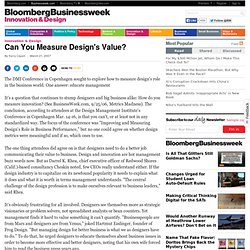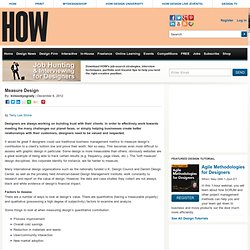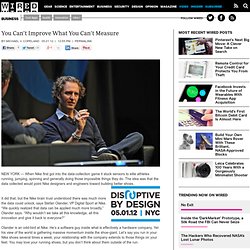

Pocket : Should designers trust their instincts — or the data? Can You Measure Design's Value? The DMI Conference in Copenhagen sought to explore how to measure design's role in the business world.

One answer: educate management It's a question that continues to stump designers and big business alike: How do you measure innovation? (See BusinessWeek.com, 9/25/06, Metrics Madness). The conclusion, according to attendees at the Design Management Institute's Conference in Copenhagen Mar. 14-16, is that you can't, or at least not in any standardized way. The focus of the conference was "Improving and Measuring Design's Role in Business Performance," but no one could agree on whether design metrics were meaningful and if so, which ones to use. Ten Ways to Measure Design's Success. As businesses increasingly recognize the power of design to provide significant benefits, executives increasingly are asking for metrics to evaluate the performance of design.
What is needed is a framework for measurement, a specific set of criteria, and methods to be used as a structure to define and measure the values of design. The following presents a framework of 10 categories that can be useful when measuring the value of design. 1. Purchase Influence One type of design that is fairly easy to measure is packaging design. 2. The design of products, communications, interfaces, and experiences can be isolated. 3. Measure Design. By Terry Lee Stone Designers are always working on building trust with their clients.

In order to effectively work towards meeting the many challenges our planet faces, or simply helping businesses create better relationships with their customers, designers need to be valued and respected. It would be great if designers could use traditional business management metrics to measure design’s contribution to a client’s bottom line and prove their worth. Not so easy. This becomes even more difficult to assess with graphic design in particular. Many international design organizations such as the nationally funded U.K.
Factors to Assess There are a number of ways to look at design’s value. Some things to look at when measuring design’s quantitative contribution: Process improvementOverall cost savingsReduction in materials and wasteUser/community interactionNew market adoption Some qualitative things to look at: Customer satisfactionBrand reputationIncreased aesthetic appealImproved functionality. Ken Carbone: Great Design: Made to Measure. Today, the words great design brilliantly light the marquee of contemporary life.

What is great design? It's a perennial question with no single answer. Everywhere we turn, we're charmed by the next new design that promises to improve our lives, whether it be a cool running shoe, an energy efficient house or the millions of apps that promise to lighten daily chores. This is all good, but how do we distinguish between good design and great design in the midst of all this "awesomeness? " In the 1950s, legendary industrial designer Henry Dreyfuss, designed products that defined America's domestic landscape.
As a practicing graphic designer I define great design by determining the difference between what might simply be a fashionable trend from work that might have a profound effect on our culture. You Can't Improve What You Can't Measure. NEW YORK — When Nike first got into the data-collection game it stuck sensors to elite athletes running, jumping, spinning and generally doing those impossible things they do.

The idea was that the data collected would point Nike designers and engineers toward building better shoes. It did that, but the Nike brain trust understood there was much more the data could unlock, says Stefan Olander, VP Digital Sport at Nike. “We quickly realized that data can be applied much more broadly,” Olander says. Return on Influence, the New ROI - Amy Jo Martin. By Amy Jo Martin | 2:33 PM September 27, 2011 Three years ago, I invented a social media metric.

I’d be lying if I said this was a divinely inspired event. I did it because it was necessary. Here’s the story: Three years ago, I was prepping for a meeting where I hoped to convince a major CPG brand that my celebrity client was more influential in social media than other celebrities, and therefore they should invest their dollars in my proposed “social media endorsement deal.” (Remember at the time, Facebook was just emerging from its college roots and Twitter was nowhere yet.) The dilemma, I knew, was the metrics. I agreed with the potential client that these were important to have, but I also knew they weren’t enough. What drives that conversion are “warm metrics”–engagement levels, viral factors, sentiment analysis. Still, I believed in this blend of cold and warm metrics. Still I had to prove it. This isn’t just about celebrities or sports teams, either.
Using Design to Pick Stocks? Slide Show >> Few things can jolt a jaded businessman out of his routine.

Walking into the Club World section of a British Airways (BAB) plane, with its award-winning pod-shaped flat beds, is one of them.